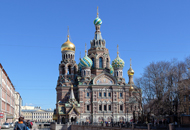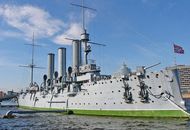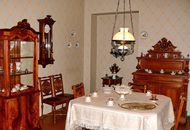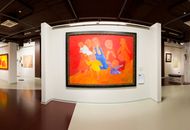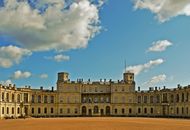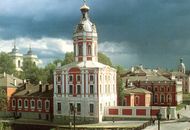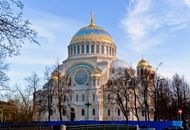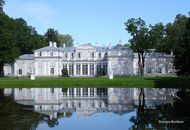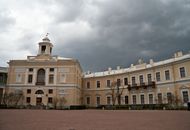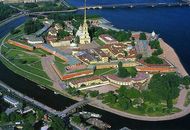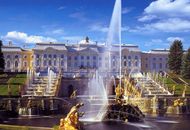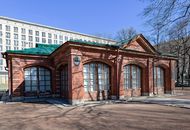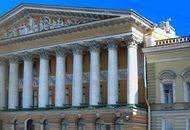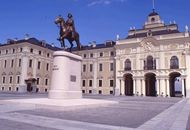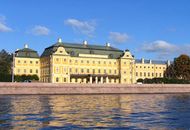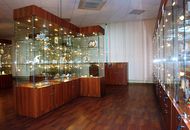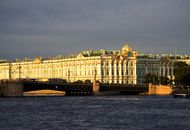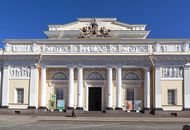Managers «Krugozor Expo Travel» will offer you the most interesting places to visit in Moscow, St Petersburg and whole Russia. Whatever you want to see in Russia — the world famous attractions or places where tourists groups rarely come, popular theater or small concert halls, luxurious restaurants or cozy family cafe — we will find what you are interested in and arrange the trip. Please select location you want to visit, so that our managers have made program specifically for you.
Select the appropriate type of holiday
The Church of Resurrection of Christ, also known as the church of the Saviour on the Spilled Blood, was built in 1887 – 1907 on the spot where Alexander II was blown up in 1881. It’s partly modeled on St. Basil’s in Moscow, as part of an effort to revive earlier Russian architecture. The Church is famous for its rich décor & mosaic attire (over 7000 m2). Five cupolas of the church (some 1000 m2) are covered with jewelry enamel. The belfry is decorated with mosaic coats of arms of cities and regions of the Russian empire.
For more than 50 years near the Petrograd embankment in St. Petersburg one can see a well-known silhouette of warship. This is cruiser Aurora, which is considered to be a monument of Russian shipbuilding and which had seen much in its life. Being a witness of many historical events of the 20th century, the cruiser took part in three wars, revolutionary events in 1917, was used as Naval College for a certain period of time and forged many generations of naval officers for Russian Navy. Now it is a museum.
The Literary-Memorial Museum of F.M. Dostoevsky was opened in 1971 for the 150th anniversary of his birth. Dostoevsky had rented an apartment in this building twice, once for a very short time in 1846, and then from 1878 till 1881. The beginning and end of his writing career turned out to be joined together in one spot. Here he wrote his last novel The Brothers Karamazov.
The Museum offers: excursions of the literary exhibitions and the memorial apartment; excursions of Dostoevsky's Petersburg (walking and bus tours).
A large literary exhibition tells us of the life and work of Dostoevsky. Through the years of its existence, the museum has developed into a research and cultural center.
2, Line 29, Vasilyevsky Island, Saint Petersburg
Show on map
The Erarta building in Saint Petersburg brings under one roof Erarta Museum, the largest private museum in Russia with over 2000 works by more than 150 artists from 15 regions of Russia in its collection, one of the branches of the international group of Erarta Galleries (others established in New York, London, Zurich and Hong Kong, which makes Erarta the biggest global project in Russian contemporary art) and other temporary exhibition spaces. The total floor space of the Erarta building is 8,000 sqm and it’s currently being expanded to a total of 10,000 sqm with a new wing due to be opened at the end of 2013.
The official opening of the 1st privately owned Faberge Museum took place in St. Petersburg on November 19, 2013 in the Shuvalov Palace.
The Faberge Museum collection contains about 4,000 works of decorative-applied and fine arts, including gold & silver items, paintings, porcelain & bronze. The core of the museum exhibits are the works of the Carl Faberge jewelry firm, acquired by Viktor Vekselberg from the American art collector Malcolm Forbes. The most valuable items in the Faberge Museum collection come from the 9 Easter Eggs created by Faberge for the last 2 Russian Tsars – Alexander III & Nicholas II.
Gatchina, situated 45 kilometers from Saint Petersburg, is included in the 'brilliant' ring of the historic parks around the former imperial capital. The Gatchina palace was built by A. Rinaldi in 1766 - 1781 and was reconstructed twice afterwards. The palace has always looked unusual to Russian spectators and in the XVIII century people affirmed with some exaggeration that it was built "in the English castle style". The building has ten towers and an underground passage. The Interiors of the palace are refined and majestic. The palace is surrounded with wonderful and extensive parks. Some nice pavilions can be visited during summer time.
The museum is located on the grounds of the Alexander Nevsky Lavra, and displays monumental sculpture and tombstones. The Lavra (a monastery of the highest rank) is a monument to history and art. Built in the course of the 18th century, it was one of St. Petersburg’s first architectural ensembles. Many eminent figures of Russian science and culture (Lomonosov, Dostoyevsky, Tchaikovsky, Glazunov, Rimsky-Korsakov) and representatives of the Russian aristocracy were buried in the Lavra’s Necropolis of the 18-20th centuries.
Kronshtadt is a small town, located on Kotlin Island, 30 kilometers west of Saint Petersburg proper near the head of the Gulf of Finland. It is also St. Petersburg's main seaport. Traditionally, the seat of the Russian admiralty and the base of the Russian Baltic Fleet were located in Kronshtadt guarding the approaches to Saint Petersburg. The historic centre of the city and its fortifications are part of the World Heritage Site Saint Petersburg and Related Groups of Monuments.
Kronshtadt has been a place of pilgrimage for Orthodox Christians for many years due to the holy memory of Saint John of Kronshtadt.
48, Bldg. A Dvortsovyy prospekt, Lomonosov, Saint Petersburg
Show on map
The architectural and landscape complex of Oranienbaum is a unique palace and park ensemble of the 18th-early 20th century, which survived World War II in its historic condition. It is situated in the distance of 40 km from St Petersburg, and being on the way after Strelna and Peterhof, it finishes the sequence of maritime residences of the Peterhof road.
The palaces-museums of Oranienbaum are located in the territory of the Upper Landscape Park and the Lower Regular Garden with the total area of 162 hectares. Its structure includes three architectural ensembles, reflecting the history of this estate throughout the 18th century.
A superb palace and park ensemble, dating from the late 18th to the 19th century, Pavlovsk was a summer residence of the Russian emperor Paul I and his family. Its architects were amongst the greatest of the period: Cameron, Brenna, Quarenghi, Voronikhin and Rossi. The landscape park, one of the largest in Europe, covers an area of 600 hectares.
The formation of the Pavlovsk Palace collections was closely connected with the journey of its owners through Europe in 1781-82. They visited workshops of well-known artists, ordering and acquiring paintings, furniture, bronze articles, silk fabrics, china sets, etc. They also brought back to Russia a large number of antique sculptures from Italy, and gifts from European royal courts. Many of these treasures are on view, together with an excellent collection of portraits by Russian artists, and a number of Pavlovsk landscape paintings and drawings.
3, Petropavlovskaya Fortress, Saint Petersburg
Show on map
Founded in 1703, the Peter & Paul Fortress is the oldest construction in St. Petersburg. It is a unique example of Russian fortification construction from the early 18thcentury. One of the main attractions in the fortress is the Peter and Paul Cathedral, built in 1712 – 1733 as the main city cathedral. Its 402 feet high belfry makes the cathedral the highest architectural structure in the city. All Russian tsars from Peter the Great onwards, except Peter II and Ivan VI are buried here. The fortress houses the Mint (1805), which is the oldest enterprise in St. Petersburg, still producing coins, medals and badges.
2, Razvodnaya ul., Peterhof, Saint Petersburg
Show on map
Peterhof, a town of parks, palaces and fountains, is a jewel of Russian art. It is situated on the Gulf of Finland, 29 km west of St. Petersburg. It was built by Peter I as a summer residence of Russian tsars to commemorate the victory over Sweden.
The Grand Palace, designed by Rastrelli, is a vast museum of lavish rooms and galleries.
The brilliant park ensemble of Peterhof includes the Upper and Lower Parks with 150 fountains and 4 monumental cascades.
Peter’s Cabin is the first residence in St. Petersburg, where Peter the Great lived while supervising the construction of the fortress and city in the early 18th century.
The exhibition of the Museum contains home utensils of the beginning of the XVIII century including personal belongings of Peter the Great, and describes Russian victories in the Northern War of 1700-1721.
St. Isaac’s Cathedral is one of the finest architectural monuments of the 19th century and one of the greatest dome constructions in the world, smaller in size only in comparison with the Cathedral of St. Peter in Rome, St. Paul’s Cathedral in London and Santa Maria del Fiore Cathedral in Florence. Grandness of this temple is shown by its size: the height of the building is 101.5 m; the length is 111.2 m; and the width is 97.6 m. It is able to accommodate about 10000 people. The cathedral is one of the dominant buildings of St. Petersburg. Its monumental and majestic image creates a unique accent in the city’s skyline.
The history of The State Memorial Museum of Leningrad Defenсe and the Siege began in 1943. It is the only military museum in the world founded during the World War II.
The collection of the museum contains original documents and possessions of townspeople and soldiers, which were preserved and later presented to the museum by Leningraders. A considerable part of the museum is devoted to the air defence, the operation of industrial enterprises and cultural institutions, and the life of children in the besieged city.
The museum is situated in the Rumyantsev Mansion.
3, Beryozovaya Alley, Strelna, Saint Petersburg
Show on map
The Konstantin Palace & Park ensemble of Strelna was built at Peter the Great’s time as a Navy residence. Its name, the Konstantin Palace, was received from its 2nd owner Grand Duke Konstantin Nikolayevich Romanov. The wine collection stored in the cellars of the Palace is unique. It consists of almost 17000 bottles. Permanent exposition is based on the collection of well-known musician M. Rostropovich and a remarkable singer G. Vishnevskaya. Since 2003 the Kostrantin Palace became “The National Congress Palace” – a perfect place for holding state events and cultural projects.
The palace of St Petersburg's first Governor, Alexander Menshikov, was erected on Vasilyevsky Island in the 1710s-1720s according to architectural plans drawn up by Giovanni Fontana and Gottfried Shaedel. The Hermitage exhibition entitled "Russian Culture in the First Third of the 18th Century" is located in the Menshikov Palace. Works of fine arts as well as decorative and applied arts from the Hermitage collection recreate the original interior decoration of Peter the Great.
The Monument to the Heroic Defenders of Leningrad was unveiled on the 9th of May, 1975. The 48-metre granite obelisk symbolizes the triumph of the victory in one of the deadliest and most destructive wars in the history of the mankind. A group sculpture around the base of the monument tells about the unity of the people and the army in the struggle against the enemy. The underground Memorial hall, housing a documentary and artistic display dedicated to the siege and defense of Leningrad, was opened on the 23rd of February, 1978.
151, Obukhovskoi Oborony Ave., Saint Petersburg
Show on map
The Museum of Porcelain was created in 1844 as a part of the Imperial Porcelain Factory. Since 2001 it has been a department of the State Hermitage. The collection includes more than 30,000 objects made in the Imperial Porcelain Factory from the 18th to the 20th century, as well as porcelain by European and domestic manufacturers.
The Russian Museum of Ethnography is one of the largest and richest museums in Russia. Its collections include objects of ethnic culture of more than 158 peoples of Russia and its neighbours. The contemporary life of the Russian Museum of Ethnography includes exhibition activities as well as providing ethnological conferences and educational programs for students and children. The collections from the Museum travel around the world and are on display at the museums of America, Netherlands, Spain, Germany, France and other countries.
The State Hermitage is one of the oldest and largest museums in the world. The collection occupies more than 350 halls in 5 different buildings including the Winter Palace, the former residence of the Russian tsars. The buildings of the Museum alone are by themselves valuable architectural monuments.
The museum collection has over 3 million exhibits from prehistoric to modern times. Especially important are the collections of prehistoric exhibits, Egyptian art, Roman and Greek art, Scythian gold and Western European paintings and sculptures.
The Russian Museum is the first state museum of Russian fine arts in the country. It was established in 1895 in St Petersburg by a decree of the Emperor Nicholas II. Its grand opening for visitors occurred on March 19 (March 7, the Old Style) 1898. The Russian Museum collection contains more than 400.000 exhibits. The main complex of museum buildings - the Mikhailovsky Palace and Benois Wing - houses the permanent exhibition of the Russian Museum, tracing the entire history of Russian art from the tenth to the twentieth centuries. The museum collection embraces all forms, genres, schools and movements of art. The Russian Museum today is a unique depository of artistic treasures, a famous restoration center, one of the major cultural and educational centers in Russia.
Summer Garden is the oldest park of the city laid out in 1704 as a French formal park decorated with genuine Italian marbles of the 18th century & fountains. The park stands out for its grille which is a fine example of iron work. The Summer Palace of Peter 1 to which the park owns its name is one of the first stone buildings in St. Petersburg (architect D. Trezzini). The interior decoration of the early 18th century style, offers a nice selection of Russian and Western-European paintings, decorative and applied art of the late 17th - beginning of the 18th centuries, as well as personal belongings of Peter the Great.
The Tsarskoye Selo palace and park ensemble is a superb monument of world-ranking architecture and garden-and-park design dating from the eighteenth to early twentieth centuries. The compositional centre of the ensemble is the Catherine Palace – a splendid example of the Russian Baroque. It is famous for the sumptuous décor of the Great Hall and the Golden Enfilade of state rooms that includes the world-famous Amber Room now returned to life. Tsarskoye Selo is also home to one of the finest creations of Classicism in architecture – the Alexander Palace. The Catherine and Alexander Parks are full of a hundred historical monuments - grand palaces and intimate pavilions, bridges and marble monuments, exotic structures imitating Gothic, Turkish and Chinese architecture.
The Yusupov Palace is the unique architectural ensemble of the XVIII-XX centuries. It is the historical and cultural monument (architect J-B. Vallin de la Mothe). From 1830 till 1917 the owners of the palace and surrounding estate were the five generations of the Yusupovs, the elite aristocratic dynasty.
The ceremonial chambers, art gallery halls, the miniature home theater, and the luxurious living quarters of the Yusupov family remained in the palace and now open to the public. The palace has also passed in the national history as the place of Grigory Rasputin murder. Now the historical and documentary exhibition is created in those rooms.
Benefits
- Official exhibition tour operator
- Individual approach to each customer
- Flexible work system
- Special program for corporate clients
- Reasonable combination of price and quality
